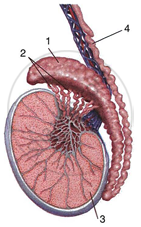Advertisements
Advertisements
प्रश्न
Match the items given in Column I with the most appropriate ones in Column II and rewrite the correct matching pairs:
| Column I | Column II | ||
| (a) | Leydig Cells | 1. | Lack of thyroxine in children |
| (b) | Stoma | 2. | 12 pairs |
| (c) | Ova | 3. | Testosterone |
| (d) | Cranial nerve | 4. | Diffusion of respiratory gases |
| (e) | Cretinism | 5. | Haploid cells |
| 6. | 31 Pairs | ||
| 7. | Diploid cells |
उत्तर
| Column I | Column II | ||
| (a) | Leydig Cells | 3. | Testosterone |
| (b) | Stoma | 4. | Diffusion of respiratory gases |
| (c) | Ova | 5. | Haploid cells |
| (d) | Cranial nerve | 2. | 12 pairs |
| (e) | Cretinism | 1. | Lack of thyroxine in children |
Explanation:
- Leydig cells: The main function of these cells is to secrete androgens, such as testosterone (a male sex hormone).
- Stoma: The stoma facilitates gas transfer between the plant's leaves and the atmosphere.
- Ova: These are female gametes, which are haploid.
- Cranial nerves: Higher vertebrates have twelve pairs of cranial nerves.
- Cretinism: It is a disorder that causes aberrant mental and physical growth in children as a result of a shortage of thyroid gland hormones, or thyroxine.
APPEARS IN
संबंधित प्रश्न
Describe the functions of the following:
Prostate gland
What are the accessory reproductive organs?
Draw a diagram of a mature human sperm. Label any three parts and write their functions.
Complete the following statement by choosing the correct alternative:
Male copulatory organ ______.
State names of organs in male reproductive system.
Identify the correct sequence of layers that cover the testis (outside to inside).
Temperature of the scrotum which is necessary for the functioning of testis is always ______ around below body temperature.
Identify A, B, C, D, in the given diagram of the human reproductive system:

Can there be any abnormal situation regarding testes location? If so, what is that and what is the harm caused due to it?
The figure given below is an important gonad of humans. Study the figure and answer the following questions.
 |
- Identify the organ. Write its specific location in the body.
- Label the parts shown in the figure as 1 to 4.
- Write important functions of parts 2 and 4.
- Name one cellular structure and one hormone which are produced in part 3.
- Draw a neat and labelled diagram of the cellular structure mentioned by you in (d).
